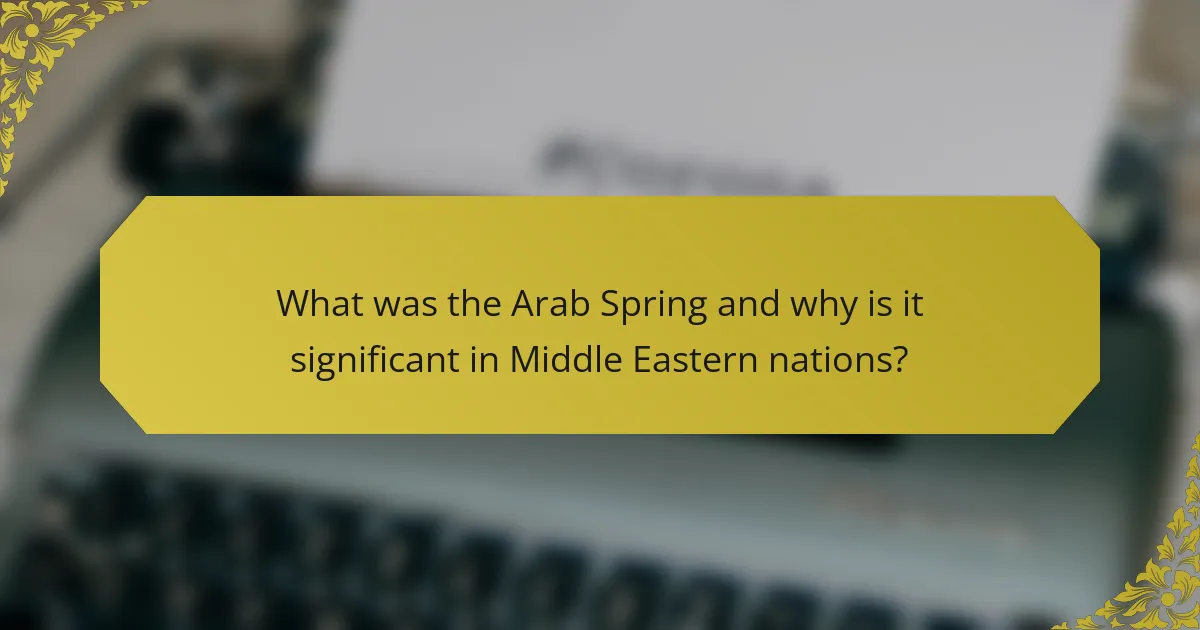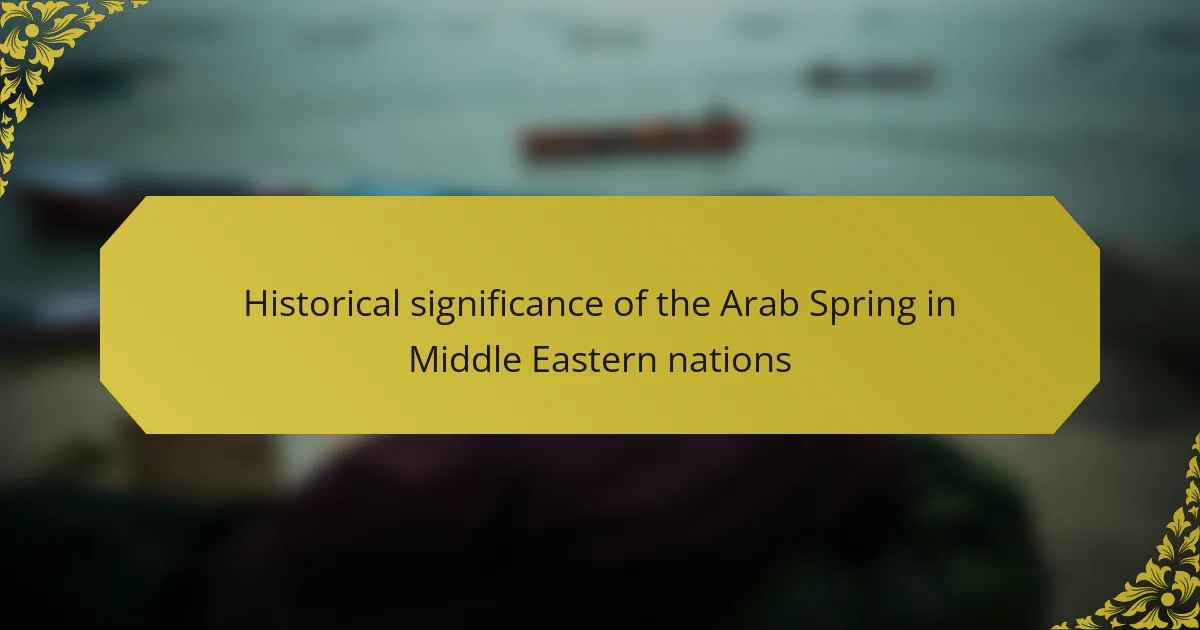
What was the Arab Spring and why is it significant in Middle Eastern nations?
The Arab Spring was a series of anti-government protests and uprisings that began in late 2010 across several Middle Eastern and North African countries. It aimed to challenge authoritarian regimes and demand political reform, social justice, and economic opportunities. The movement started in Tunisia with the self-immolation of Mohamed Bouazizi, which sparked widespread protests.
Significance lies in its impact on regional politics. The Arab Spring led to the overthrow of long-standing leaders in Tunisia, Egypt, Libya, and Yemen. It also prompted civil wars, particularly in Syria and Libya, resulting in ongoing conflicts. The uprisings highlighted widespread discontent with corruption, unemployment, and lack of freedoms.
The Arab Spring reshaped the political landscape in the Middle East. It inspired similar movements globally, demonstrating the power of grassroots activism. The outcomes varied, with some nations experiencing democratic transitions while others descended into chaos. Overall, the Arab Spring marked a pivotal moment in the struggle for democracy and human rights in the region.
How did the Arab Spring begin and what were its main causes?
The Arab Spring began in December 2010 with the self-immolation of Mohamed Bouazizi in Tunisia. His act of protest against police corruption and ill-treatment sparked widespread demonstrations. Citizens demanded political reform, economic opportunities, and an end to authoritarian regimes. The movement quickly spread to countries like Egypt, Libya, and Syria. Key causes included high unemployment, rising food prices, and government repression. Social media played a crucial role in mobilizing protests and sharing information. These factors combined created a powerful desire for change across the region. The Arab Spring led to varying outcomes, including regime changes and ongoing conflicts.
What socio-political factors contributed to the outbreak of the Arab Spring?
The socio-political factors that contributed to the outbreak of the Arab Spring include widespread corruption, lack of political freedom, and economic hardship. Many citizens faced high unemployment rates and rising food prices. Authoritarian regimes suppressed dissent and limited civil liberties. The influence of social media facilitated organization and mobilization among protesters. Additionally, regional discontent with governance fueled collective action. The self-immolation of Mohamed Bouazizi in Tunisia sparked protests that spread across the region. This event highlighted the desperation of citizens under oppressive regimes. Ultimately, these factors combined to ignite a series of uprisings across multiple Middle Eastern nations.
How did economic conditions influence the Arab Spring movements?
Economic conditions significantly influenced the Arab Spring movements by exacerbating public discontent. High unemployment rates, particularly among youth, fueled frustration. Inflation and rising food prices further strained household budgets. Many citizens faced poverty and economic stagnation, leading to widespread protests. The lack of economic opportunities contributed to demands for political reform. In Tunisia, the self-immolation of Mohamed Bouazizi highlighted these economic grievances. His actions triggered protests that spread across the region. Economic hardships served as a catalyst for the Arab Spring, pushing citizens to seek change.
What were the key events during the Arab Spring in various Middle Eastern nations?
The key events during the Arab Spring included widespread protests and uprisings across several Middle Eastern nations. In Tunisia, protests began in December 2010, leading to the ousting of President Zine El Abidine Ben Ali in January 2011. Egypt saw massive demonstrations in Tahrir Square, resulting in President Hosni Mubarak’s resignation in February 2011. Libya experienced a civil war, which led to the overthrow of Muammar Gaddafi in October 2011. In Syria, protests escalated into a prolonged civil war starting in March 2011, leading to significant humanitarian crises. Yemen’s President Ali Abdullah Saleh resigned in November 2011 after months of protests. Bahrain faced protests demanding reforms, which were met with a crackdown by the government. Each of these events represented a significant challenge to authoritarian regimes in the region.
Which countries were most affected by the Arab Spring and what were their experiences?
The countries most affected by the Arab Spring include Tunisia, Egypt, Libya, Syria, and Yemen. Tunisia experienced the first protests, leading to the ousting of President Ben Ali in January 2011. Egypt followed with mass protests that resulted in President Mubarak’s resignation in February 2011. Libya descended into civil war, leading to the overthrow of Muammar Gaddafi in October 2011. Syria faced a brutal conflict that began with protests against President Bashar al-Assad, resulting in a prolonged civil war. Yemen’s protests led to President Saleh’s resignation, but the country has since faced ongoing conflict and humanitarian crises. Each of these nations faced varying degrees of violence, political instability, and social upheaval as a result of the Arab Spring.
What role did social media play in the Arab Spring protests?
Social media played a crucial role in the Arab Spring protests by facilitating communication and organization among activists. Platforms like Facebook and Twitter allowed individuals to share information quickly. This rapid dissemination of news helped mobilize large crowds in various countries. For instance, in Tunisia, social media was instrumental in organizing protests against the government. The use of hashtags and viral posts amplified calls for action. Additionally, social media provided a space for citizens to express dissent and share their experiences. This visibility garnered international attention and support for the movements. Reports indicate that social media was a key factor in the success of protests in countries such as Egypt and Libya. Overall, social media transformed the way protests were organized and communicated during the Arab Spring.
How did the Arab Spring impact governance and political structures in the region?
The Arab Spring significantly altered governance and political structures in the region. It led to the overthrow of several long-standing authoritarian regimes. Countries like Tunisia, Egypt, and Libya experienced regime changes. In Tunisia, the revolution resulted in a transition to a democratic government. Egypt saw the ousting of President Hosni Mubarak, followed by a brief period of Islamist rule. Libya’s civil war ended with the fall of Muammar Gaddafi, creating a power vacuum.
The uprisings prompted discussions about political reform and accountability. Many governments faced increased pressure to address corruption and human rights abuses. Some regimes implemented limited reforms to maintain stability. In contrast, others responded with violence, leading to further unrest. The Arab Spring highlighted the demand for greater political participation. It also exposed the fragility of existing political structures in the region. Overall, the Arab Spring reshaped the political landscape, fostering both hope and turmoil.
What changes occurred in leadership and governance post-Arab Spring?
Post-Arab Spring, leadership and governance underwent significant transformations in several Middle Eastern nations. In Tunisia, the revolution led to the establishment of a democratic government. The first free elections were held in 2011, resulting in the Ennahda party gaining power. Egypt experienced a brief period of democratic governance after President Hosni Mubarak’s ousting in 2011. However, this was followed by a military coup in 2013, leading to the consolidation of power under President Abdel Fattah el-Sisi.
In Libya, the overthrow of Muammar Gaddafi resulted in a power vacuum. This led to ongoing conflict among rival factions and a struggle for control over governance. Yemen faced a similar fate, with President Ali Abdullah Saleh being ousted. The country descended into civil war, complicating governance and leadership structures.
Syria’s situation differed significantly, as the civil unrest escalated into a protracted civil war. Bashar al-Assad retained power, but his government faced severe challenges from various opposition groups. Overall, the Arab Spring catalyzed a wave of leadership changes and governance challenges across the region, with varying outcomes in each country.
How did the Arab Spring influence democratic movements in the Middle East?
The Arab Spring significantly influenced democratic movements in the Middle East by inspiring widespread protests against authoritarian regimes. It began in December 2010 in Tunisia, leading to the ousting of long-standing leaders. This wave of activism spread to countries like Egypt, Libya, and Syria, where citizens demanded political reforms. The protests highlighted the population’s desire for democracy, accountability, and human rights. In Egypt, the movement resulted in the removal of President Hosni Mubarak in early 2011. The Arab Spring also led to the establishment of temporary democratic frameworks in several nations, although outcomes varied widely. Some countries experienced civil unrest and conflict, while others saw limited reforms. Overall, the Arab Spring reshaped the political landscape, igniting aspirations for democratic governance across the region.
What were the immediate and long-term consequences of the Arab Spring?
The immediate consequences of the Arab Spring included widespread protests and the overthrow of several authoritarian regimes. Tunisia’s President Zine El Abidine Ben Ali was ousted in January 2011. Egypt’s President Hosni Mubarak followed in February 2011. Libya’s Muammar Gaddafi was killed in October 2011 after a civil war. These events led to significant political changes in the region.
Long-term consequences included ongoing instability and civil wars in countries like Syria and Yemen. The Arab Spring did not lead to widespread democratic reforms as many had hoped. Instead, some nations experienced a return to authoritarian rule or military governance. Economic challenges intensified in several countries, exacerbating social unrest. The Arab Spring also influenced movements in other regions, inspiring protests and calls for reform globally.
How did the Arab Spring affect human rights and civil liberties in the region?
The Arab Spring significantly impacted human rights and civil liberties in the region. It sparked widespread protests against authoritarian regimes. Citizens demanded greater freedoms and political reforms. In countries like Tunisia and Egypt, initial successes led to increased political participation. However, the aftermath saw a backlash in several nations. Governments intensified repression to maintain control. Human rights violations rose, including arbitrary detentions and censorship. The situation in Syria deteriorated into a civil war, worsening human rights conditions. Overall, while the Arab Spring raised awareness, it resulted in mixed outcomes for civil liberties across the region.
What economic impacts resulted from the Arab Spring movements?
The Arab Spring movements resulted in significant economic impacts across the Middle East. Many countries experienced a decline in foreign investment due to political instability. For instance, Egypt saw its foreign direct investment drop by 30% in 2011. Unemployment rates surged, particularly among youth, with rates exceeding 25% in countries like Tunisia and Libya. Tourism, a vital economic sector, faced severe disruptions. In Egypt, tourist arrivals fell by 40% in the aftermath of the protests. Additionally, some nations faced increased inflation rates, affecting purchasing power. The economic challenges led to social unrest, further complicating recovery efforts. Overall, the Arab Spring movements reshaped economic landscapes in the region, leading to long-term consequences.
How did the international community respond to the Arab Spring?
The international community responded to the Arab Spring with varied reactions. Many Western nations supported the protests, advocating for democratic reforms. The United States and European Union imposed sanctions on regimes that violently suppressed dissent. Some countries, like France and the UK, provided diplomatic support to opposition groups. The United Nations called for peaceful resolutions and condemned human rights violations. In contrast, nations such as Russia and China opposed intervention, emphasizing state sovereignty. The international response included humanitarian aid to affected regions, particularly in Libya and Syria. Overall, the response was marked by a mix of support, criticism, and caution regarding military intervention.
What role did foreign governments play during and after the Arab Spring?
Foreign governments played significant roles during and after the Arab Spring by influencing political outcomes and providing support. Many countries, particularly the United States and European nations, initially supported the protests against authoritarian regimes. They expressed public backing for democratic reforms and human rights.
However, as the situation evolved, foreign governments shifted their strategies. Some intervened militarily, such as NATO’s involvement in Libya, which aimed to protect civilians and ultimately led to regime change. Others, like Russia and Iran, supported existing regimes to maintain their influence in the region.
Post-revolution, foreign governments continued to engage in the region through aid, diplomatic efforts, and military support. For instance, the U.S. provided financial assistance to Egypt and Tunisia to promote stability and democracy. Conversely, some nations, like Saudi Arabia, focused on countering the spread of movements they viewed as threats.
These actions illustrate the complex interplay of foreign interests and regional dynamics during and after the Arab Spring. The outcomes of these interventions have had lasting impacts on the political landscape in Middle Eastern nations.
How did international organizations address the changes brought by the Arab Spring?
International organizations responded to the changes brought by the Arab Spring through various initiatives. The United Nations emphasized the need for political reform and human rights protection. It organized conferences to facilitate dialogue among affected nations. The Arab League promoted economic assistance to stabilize transitioning governments. The World Bank provided financial support for development projects in impacted countries. Additionally, the African Union encouraged democratic governance in North Africa. These actions aimed to foster stability and support democratic processes post-revolution.
What lessons can be learned from the Arab Spring in terms of future movements?
The Arab Spring teaches that grassroots mobilization is crucial for successful movements. It demonstrated the power of social media in organizing protests and spreading information. The movement highlighted the importance of unity among diverse groups. It also showed that external support can influence outcomes, as seen with international reactions. Additionally, the aftermath revealed the risks of power vacuums leading to instability. Finally, it emphasized the need for clear goals and strategies to sustain momentum. These lessons are vital for future movements seeking change in oppressive regimes.
What strategies can emerging movements adopt based on the Arab Spring’s outcomes?
Emerging movements can adopt strategies focused on grassroots mobilization and digital activism based on the Arab Spring’s outcomes. Grassroots mobilization fosters community engagement and local leadership. This approach encourages participation from diverse demographics, enhancing inclusivity. Digital activism leverages social media platforms for rapid information dissemination. The Arab Spring demonstrated the power of online networks in organizing protests and sharing narratives. Movements can utilize these platforms to build solidarity and raise awareness. Additionally, forming coalitions with existing organizations can strengthen their reach and impact. This strategy promotes resource sharing and collective action. Lastly, prioritizing clear, achievable goals can maintain momentum and public support. The Arab Spring illustrated the importance of a unified vision in sustaining movements.
How can understanding the Arab Spring help in addressing current regional issues?
Understanding the Arab Spring can provide valuable insights for addressing current regional issues. The Arab Spring highlighted the demand for political reform and social justice in the Middle East. It revealed the consequences of authoritarian governance and the importance of public engagement in political processes. Countries facing similar unrest today can learn from the outcomes of the Arab Spring, both positive and negative. For example, Tunisia’s successful transition to democracy offers a model for reform. Conversely, the violent responses in Syria and Libya illustrate the risks of ignoring public grievances. Analyzing these events helps policymakers identify effective strategies for conflict resolution and governance. Furthermore, understanding the socio-economic factors that fueled the Arab Spring can aid in addressing ongoing economic disparities in the region.
What practical insights can be drawn from the historical significance of the Arab Spring?
The Arab Spring demonstrates the power of grassroots movements in enacting political change. Citizens mobilized against oppressive regimes, highlighting the demand for democracy and human rights. Social media played a crucial role in organizing protests and disseminating information. The uprisings led to significant political shifts in countries like Tunisia and Egypt. However, the outcomes varied, with some nations experiencing civil conflict and instability. The Arab Spring underscores the importance of addressing socio-economic grievances to prevent unrest. It also illustrates the challenges of transitioning from authoritarian rule to democratic governance. Overall, the Arab Spring serves as a case study for understanding the dynamics of social movements and their impact on governance in the Middle East.
The Arab Spring refers to a series of anti-government protests and uprisings that began in late 2010 across various Middle Eastern and North African countries, primarily driven by demands for political reform, social justice, and economic opportunities. The movement was ignited by the self-immolation of Mohamed Bouazizi in Tunisia, leading to the overthrow of long-standing leaders in Tunisia, Egypt, Libya, and Yemen, while also resulting in civil wars in Syria and Libya. Key socio-political factors included widespread corruption, high unemployment, and government repression, with social media playing a pivotal role in organizing protests. The Arab Spring significantly impacted governance and political structures, inspiring both democratic movements and ongoing conflicts, highlighting the complex interplay of local grievances and international responses.


